The Book of Exodus contains both some of the most famous and exciting parts of the Old Testament, as well as some of the most tedious. It can be easy to lose track of where the story is up to when you are wading through long descriptions of Passover preparation, or how to build the Tabernacle. This post is intended to give an overview of Exodus with the intention of making reading the book easier. This truly is a wonderful part of God’s word!
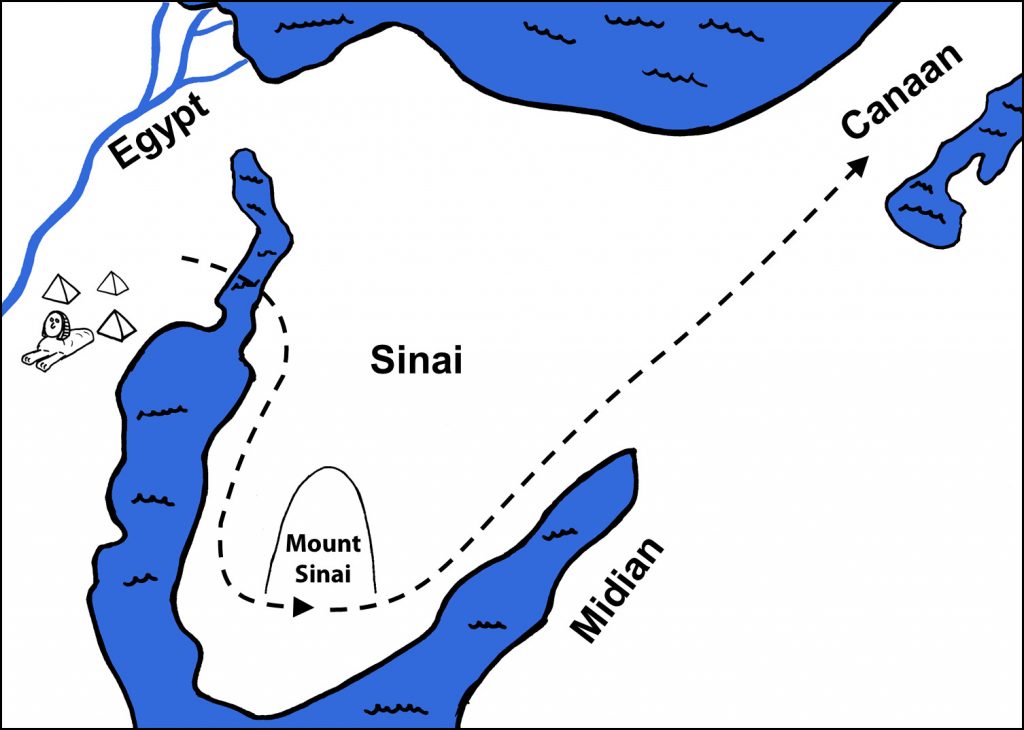
Exodus moves from Egypt to Mt Sinai, with a view to completing the journey to the Promised Land. YHWH (‘Yahweh’ – this is Israel’s God’s personal name) decides to rescue Israel out of slavery in Egypt and bring them to Mt. Sinai where he would make them into a nation over which he would personally rule. From there he would guide them to the Promised Land of Canaan where Israel would live with YHWH as their God. He would bless their lives there and through them he would eventually bless the whole world, in fulfilment of his promises to Israel’s ancestor Abraham (Genesis 12:1-3).
1. Setting (Exodus 1-2)
Exodus begins in Egypt where Israel’s ancestor Joseph had invited them to live (Genesis 50). Initially they were a large extended family of 70 people, but in the 400 years since had grown to such a size that Pharaoh found their presence intimidating and enslaved them in an attempt to quash any threat that they might pose. When this proved an inadequate strategy Pharaoh ordered that Israelite baby boys be murdered by being thrown in the Nile (Exodus 1:22)!
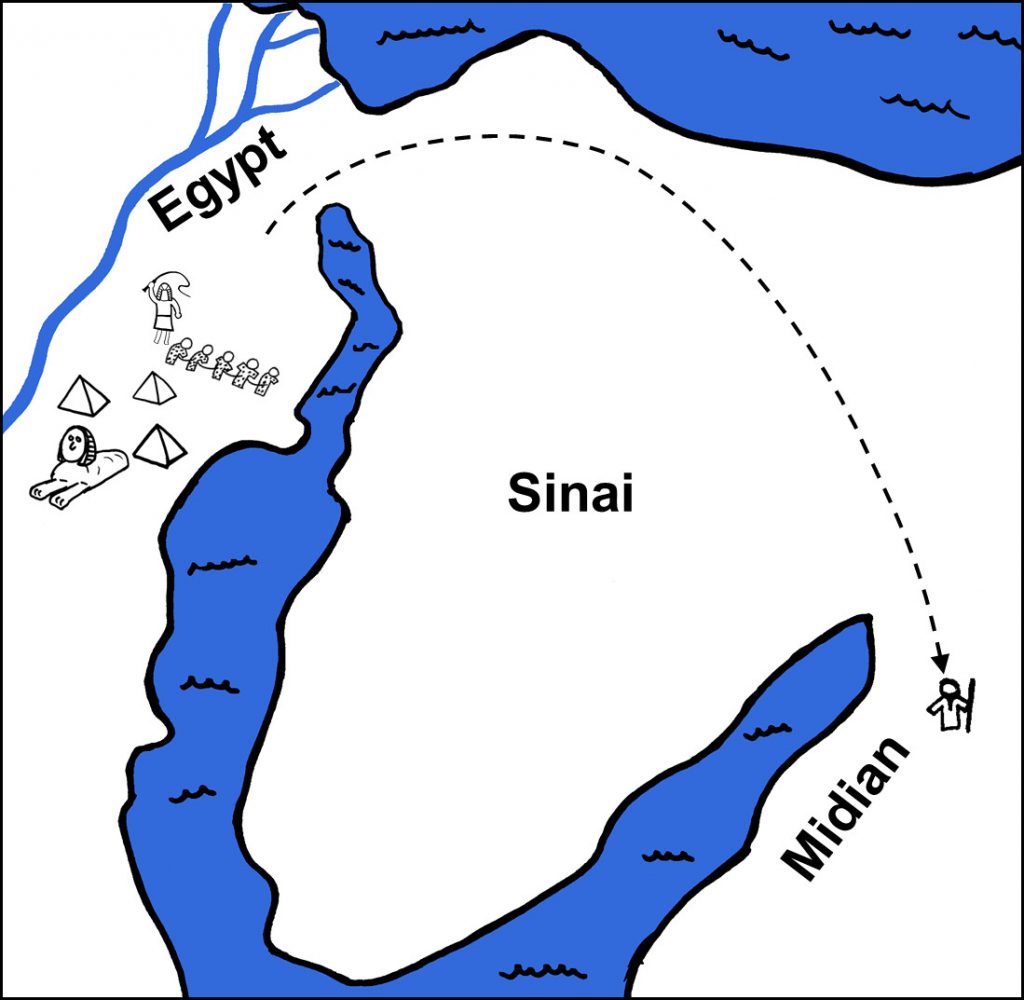
Moses was one Israelite infant who was spared this fate. His mother put him into a basket on the river for safety (!). In God’s kindness he was found by none other than Pharaoh’s daughter, who raised him as her own (Exodus 2:1-10). When Moses grew up he became alarmed at the oppression of his countrymen, ended up killing a Israelite-beating Egyptian, and then fled in fear. He ended up in Midian where he married a daughter of Jethro, and became a shepherd (Exodus 2:11-25). Little did he know that soon he would become the shepherd of God’s people.
2. Moses Commissioned (Exodus 3-6)
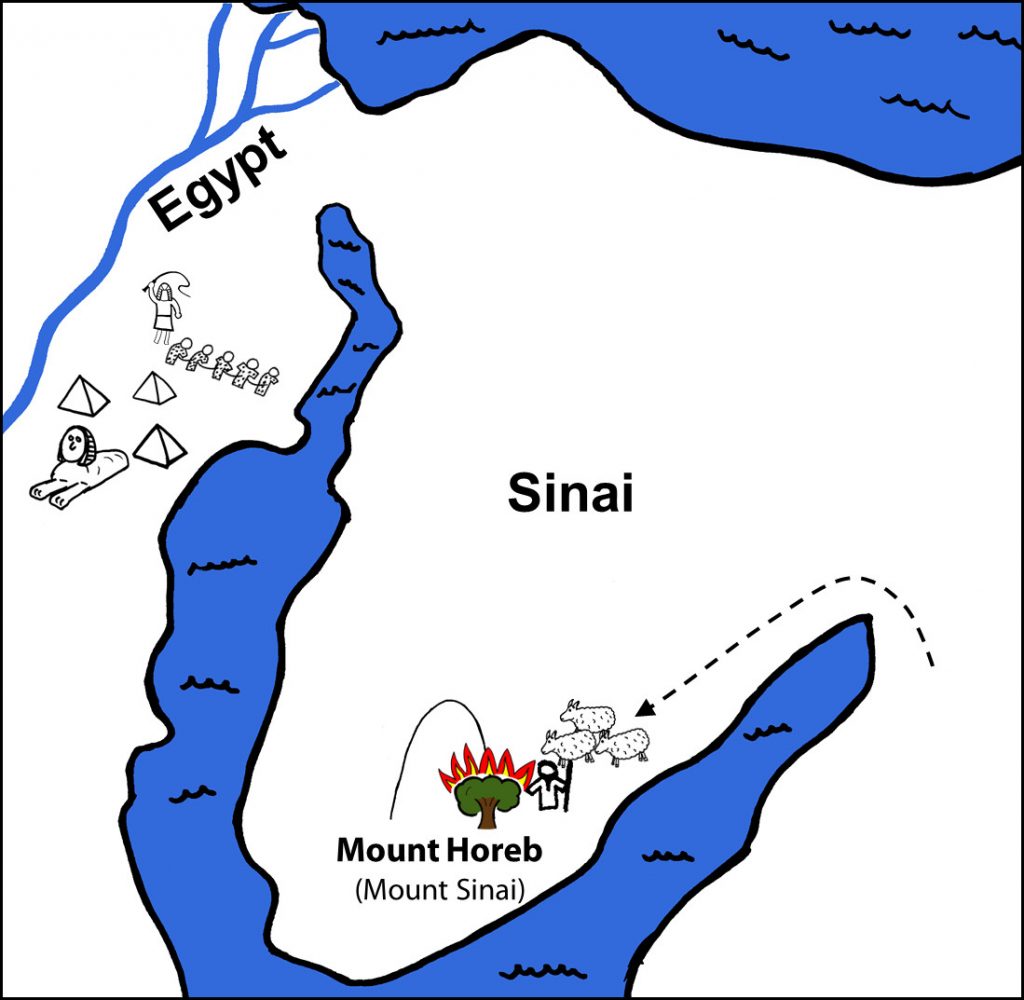
Moses once took his flock out to Mt Horeb (Mt Sinai). There he saw a bush that was on fire but (miraculously) not being burned up. Moses investigated, and God introduced himself to Moses as the God of his ancestors who would be known through his deeds (literally: “I am who I am” or “I will be who I will be”. In other words: “pay attention and watch what I do next!”, Exodus 3:14). It would be as though God had reached out his arm, scooped Israel out of Egypt, and landed them safely at Mt Sinai (Exodus 6:6; 8:19). He commissioned Moses to lead Israel out of slavery, equipped him with a message for Israel and Pharaoh, appointed him to perform miraculous wonders, and even brought Moses’ brother Aaron along to do the talking (Exodus 3:1-4:17). Off to Egypt!
3. Plagues: YHWH vs. the gods of Egypt (Exodus 7-10)
Moses announced a range of miraculous plagues that would demonstrate that Israel’s God was greater than the Egyptian gods (Exodus 12:12). This would give urgent reason for Pharaoh to release Israel. For a while Pharaoh followed a pattern of promising to release Israel if Moses stopped the plague, only to ‘harden his heart’ and break his promise once the plague ended (Exodus 7:22; 8:14, 19, 32; 9:34-35). After a while this changed, and it was God who hardened Pharaoh’s heart so as to complete the sequence of signs he had planned (Exodus 9:12; 10:20, 27; 11:10). Why? Didn’t he want Israel freed? Yes, but God had also planned this occasion to demonstrate to Israel and all the world that he was the true God (Exodus 9:16, 10:1-2). God intended that these events would demonstrate to an evil, idol-worshipping world that he alone was God. Israel’s rescue would put the incomparible power of Israel’s God on display before the watching world. And the strategy would work. On the way to the Promised Land many nations afterwards would tremble at the hearing of Israel (and their God) coming (Exodus 15:14-16; Joshua 2:9-10; 9:9)!
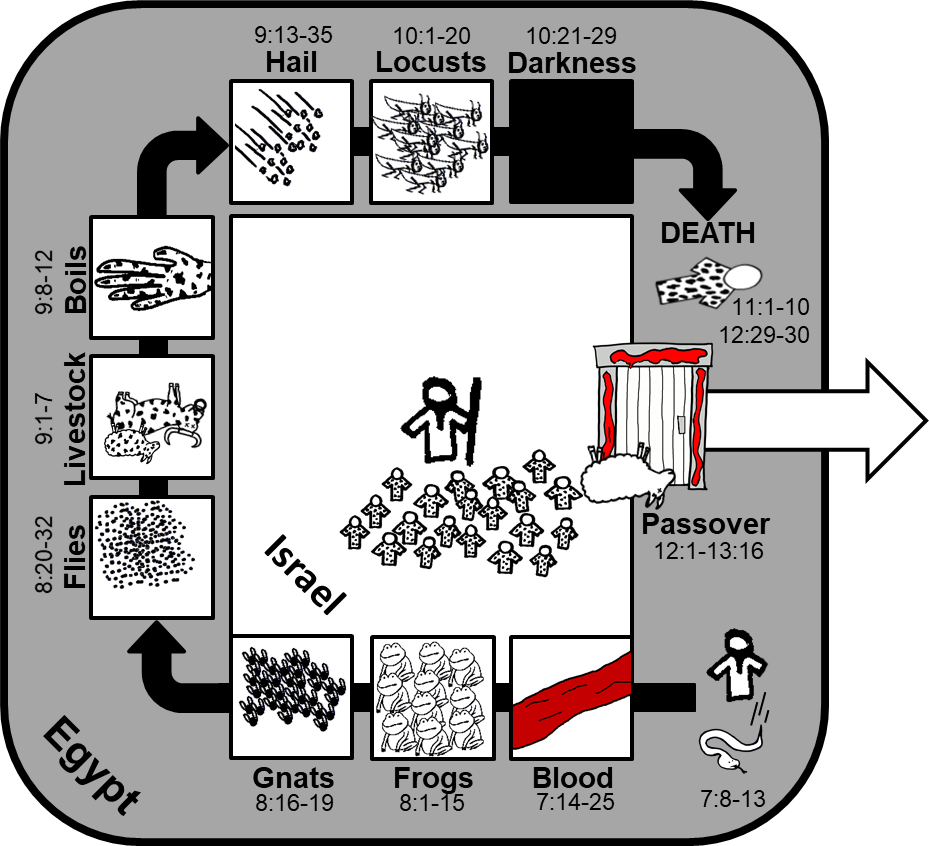
4. Salvation by Blood & through Water (Exodus 11-15)
Exodus features two great salvation events (or one event with two parts?). The tenth and last plague was the death of the firstborn of every family in Egypt. Previously the plagues had mostly distinguished between Israel and Egypt without any action necessary on Israel’s part (Exodus 8:22; 9:7, 26; 10:23; 11:7). Now the distinction would be the response of faith (cf. Exodus 9:20). Israelite families needed to sacrifice a lamb and paint their door-frames with its blood (Exodus 12:7). Their households would then not experience death since a substitute had died instead. Death would ‘pass over’ them.
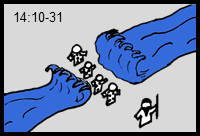
The greatest act of Israel’s salvation occurred after they departed Egypt. After the tenth plague they plundering the demoralised Egyptians’ wealth like a conquering army (Exodus 12:36). But Pharaoh soon missed his slaves and chased Israel down with a real army (Exodus 14:5-9). Israel became trapped between the Egyptian army and the sea. They panicked! But YHWH would fight to save his people (Exodus 14:14). From the time of their escape, God had guided Israel by a pillar of cloud in the sky which obscured the glory of his presence (his glory shone through the cloud as ‘fire’ at night, Exodus 13:21-22). The cloud shielded Israel from the Egyptians whilst Moses raised his staff and the sea parted. Israel travelled through safely but the sea crashed in on the pursuing Egyptians, drowning all of them (Exodus 14:19-31). Israel sang to commemorate the great lesson they had learned: their God was a warrior saviour (Exodus 15:2-3)!
5. Journey of Grumbling (Exodus 16-18)
Israel ‘put their trust’ in YHWH when they saw the Egyptian army defeated (Exodus 14:31), but their faith didn’t last long. God led them through the wilderness whilst Israel grumbled bitterly and even wished to return to Egyptian slavery (Exodus 16:2-3; 17:3-7). Yet God faithfully provided food and water for them along the way and ensured their safe arrival at Mt Sinai.
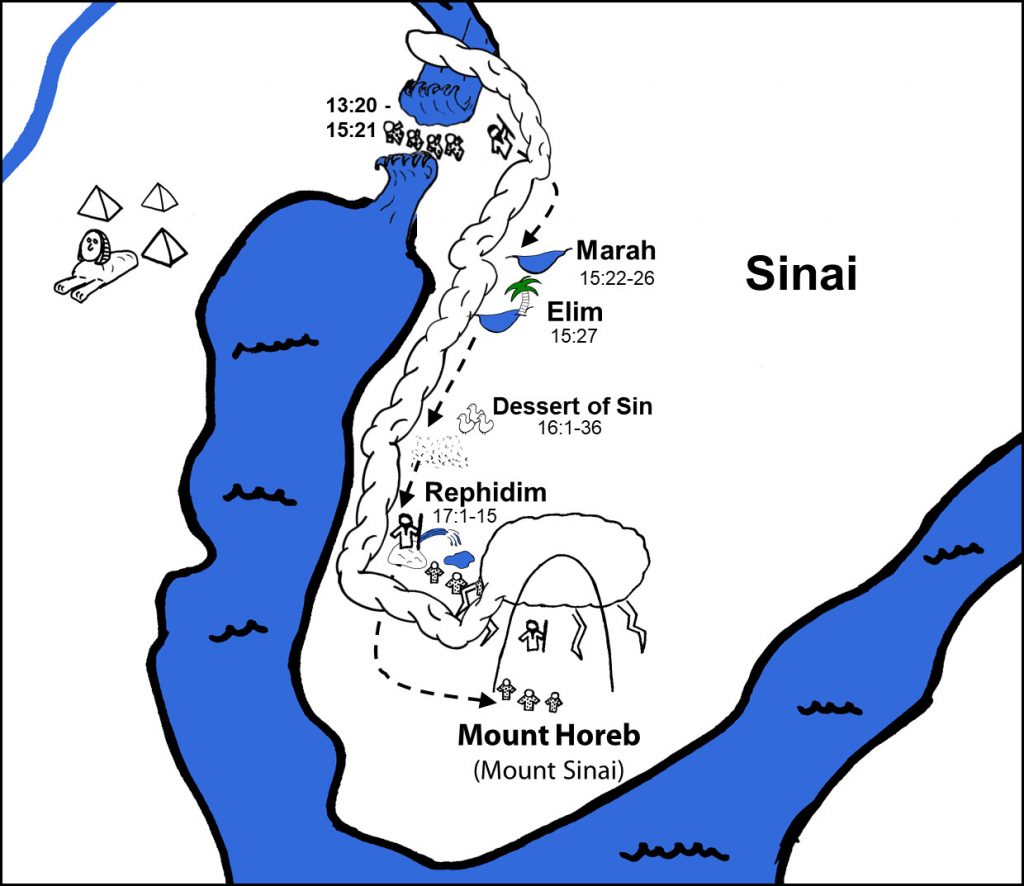
6. Mt Sinai (Exodus 19-24)
Israel would remain at Mt. Sinai for quite some time. They stay there for the next 22 chapters of Exodus, all of Leviticus, and the first 10 chapters of Numbers (cf. Exodus 10:11-13). The story begins to slow down and it is easy to get lost in the details.
At Sinai, Israel goes from being a large family to becoming a nation with a king (God) and a constitution (the Law). Specifically they are to be a ‘kingdom of priests’ who would introduce God to the world (Exodus 19:5-6).
The day of Israel’s first meeting with their God arrived. Nothing could have prepared them. YHWH came down from heaven onto the peak of Sinai to meet the people he had rescued. The whole thing was terrifying and displayed God’s holy response to sinners who come close to his presence. The mountain was engulfed in smoke, fire, and lightening, and the air was filled with thunder and trumpet blasts (Exodus 19:16-19). The people were strictly warned not to approach lest they die, but they were already too terrified to listen to God much less approach him (Exodus 19:23-24; 20:19). Moses took on the role of mediator, going up and down the mountain to establish the terms of the covenant, receiving the ’10 Commandments’ (Exodus 20:1-17) and instructions from God on how to apply those principles in various cases and situations (21-23).
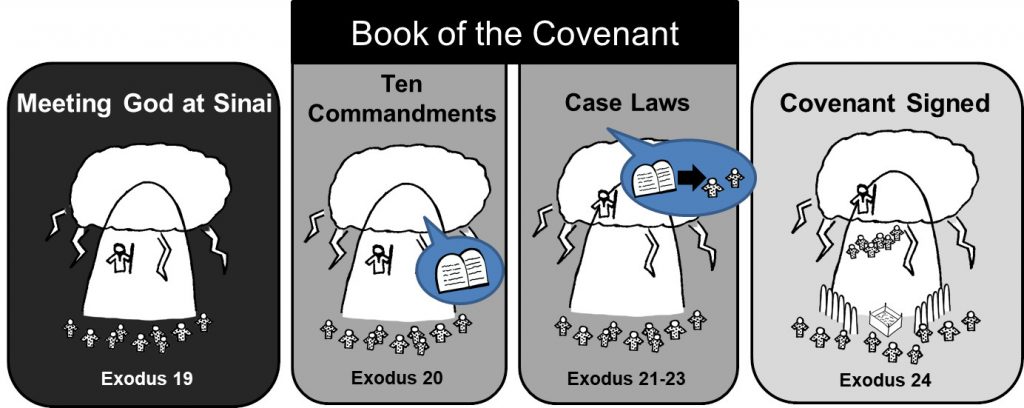
The people agreed to the terms of God’s covenant (Exodus 24:3). It was formally sealed with sprinkled blood (Exodus 24:8) and an extraordinary covenant formalisation feast commenced. Moses took Israel’s elders up onto the mountain and they ate a meal in God’s presence, seemingly sitting at the boundary between heaven and earth (Exodus 24:9-11)! From there Moses continued further up the mountain alone, entering the inferno of God’s presence. He remained with God for 40 days and 40 nights whilst Israel waited below (Exodus 24:12-18).
7. Tabernacle Plans (Exodus 25-31)
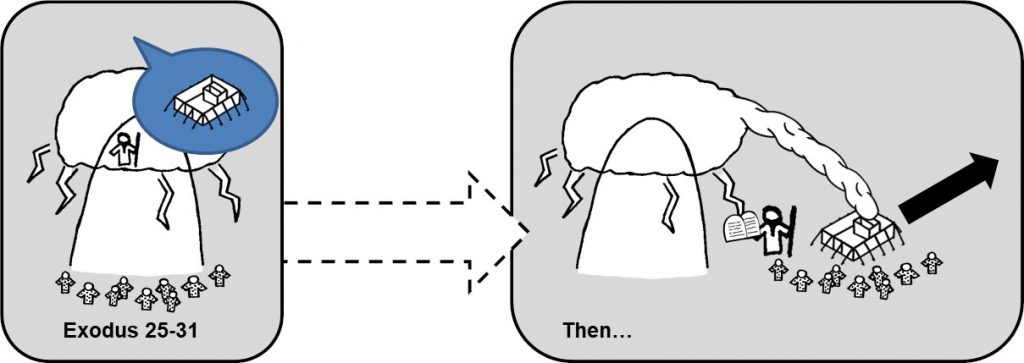
Exodus 25-31 is a set of detailed instructions that God gave Moses outlining how to build the Tabernacle. That may seem boring, but it is one of the most important parts of the book of Exodus. For now, it suffices to say that the Tabernacle was a temple-like tent that would function as a moveable Mt. Sinai. Just as God dwelt among Israel hidden behind the cloud that rested on the mountain, so he would live among them whilst they travelled to Canaan. Instead of remaining stationary above them on the mountain, the cloud would now settle on the Tabernacle, with several layered sections shielding Israel from God’s holy presence. God would thus dwell among Israel (Exodus 25:8-9) whilst also remaining unapproachable to sinners.
The next step was supposed to be that Moses would come down with the 10 Commandments and God’s instructions on how to build the Tabernacle. Israel would build it, God would fill it, and then God would lead his new people to the Promised Land. What happened instead was truly devastating…
8. Idolatry, Intercession & Renewal (Exodus 32-34)
After 40 days Moses descended the mountain to find Israel worshipping a golden cow that they had made. They attributed their salvation to the statue and called it YHWH (Exodus 32:1-6). It probably seems utterly ludicrous to us that Israel would do this, but in that era this was religious common-sense. People ‘knew’ that the way to honour gods was through statues. So Israel ignored God’s explicit command against idols (Exodus 20:4-6), ignored the fire-engulfed mountain of his presence above them, and tried to be ‘smart theologians’ by the standards of their era. They broke the covenant before the paperwork (stone-work?) had even been filed. What a bitter irony that the gold Israel plundered from Egypt would have been used for God’s Tabernacle, but was used to make an idol to replace him instead!
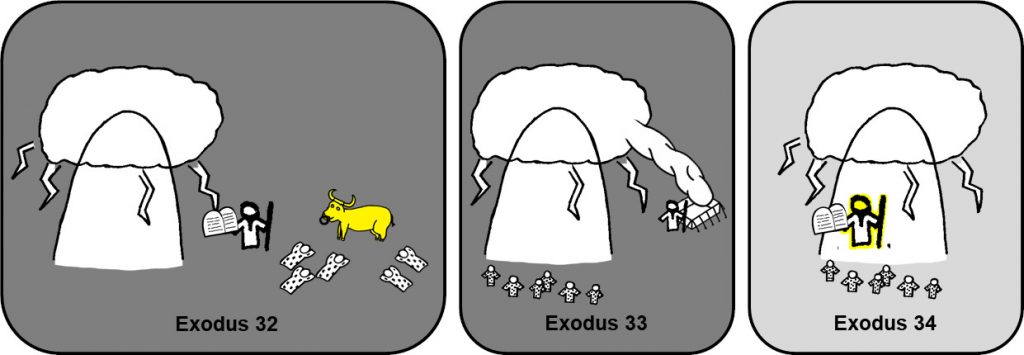
God was furious at Israel’s betrayal. The relationship was as utterly broken as it possibly could have been. Israel might have been destroyed and replaced by Moses as the recipient of God’s blessings (Exodus 32:9). For a while Moses even had his own Tabernacle-like tent to meet God in whilst the rest of Israel remained at a distance from the God that they had betrayed and rejected (Exodus 33:7-11). Through Moses’ mediation, eventually the covenant was renewed and Israel was restored (Exodus 32:11-14, 30-32; 33:12-17; 34:10-28). In the process Moses was give deeper insight into YHWH’s character (Exodus 33:18-34:7) and his face took on a radiance from being in God’s presence that terrified the other Israelites (Exodus 34:29-35).
9. Tabernacle Construction (Exodus 35-40)
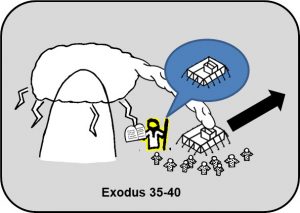
Exodus 25-31 gave the instructions for the Tabernacle. Exodus 35-40 essentially repeats those instructions to show that Israel followed them to the letter (Exodus 39:42-43). I wonder: did Israel ever get anything else right in its history? Moses had a rare ‘good day at work’ that day!
The cloud covered the completed Tabernacle and the glory of God’s presence filled it so that even Moses couldn’t enter (Exodus 40:34-38). This shouldn’t be surprising. Moses’ experience at Sinai of entering God’s presence unharmed was a unique part of establishing YHWH’s covenant relationship with Israel. It was not to be repeated. From here the book of Leviticus would be introduced as the ‘user manual’ for the Tabernacle, laying out an entire system for what it takes for sinners to come near to the holy God.
Israel was now ready to depart Sinai with God leading the way in cloud and fire, and settling on the Tabernacle when Israel camped. Israel had been saved out of slavery, had been made God’s people, and would now journey onward to God’s promised land of blessing.
Next up: a Tour of the Tabernacle
Hear more on Exodus 16-40 from my guest appearance on the ‘Old News Bible’ podcast:
